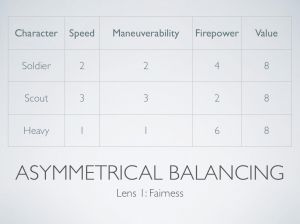 These last few weeks I’ve been doing a series of presentations out of a fantastic book on game design, The Art of Game Design – A Book of Lenses, by Jesse Schell.
These last few weeks I’ve been doing a series of presentations out of a fantastic book on game design, The Art of Game Design – A Book of Lenses, by Jesse Schell.
In the beginning of chapter 11, Jesse begins the description of two ways that fairness can be created in multiplayer gaming. The first is what is called symmetrical balance and many games such as football, chess, tennis and halo use this to create a fairness in play.
I think the most simple example of symmetrical balance is found in the classic game of tic-tac-toe. In this game, both players have the same actions available to them, namely the ability to fill any of the empty squares with their symbol. They are able to do this once per turn, then they wait for their opponent to make their move. The players also have an identical goal to win the game; they must place their symbols so that three are in a row either horizontally, vertically or diagonally. The first player to do this wins.
Because both players have identical affordances and goals, this game is completely symmetrical. The only imbalance is deciding which player goes first, which gives them a slight advantage. In many games like this, a random draw to decide clears up this final problem.
 On the other hand, asymmetrical games give players different possible moves or different goals to win. On the simple side of things, the board game risk does this when played by the mission rules. Here players have the same kinds of moves, but they have different goals. A more complicated example is one of my current favorite games, Team Fortress 2.
On the other hand, asymmetrical games give players different possible moves or different goals to win. On the simple side of things, the board game risk does this when played by the mission rules. Here players have the same kinds of moves, but they have different goals. A more complicated example is one of my current favorite games, Team Fortress 2.
TF2 has 9 player types, including:
- The heavy – has a huge machine gun and a lot of life, but moves very slowly
- The scout – has a small shotgun for close range combat, little life and moves very fast
- The engineer – has a shotgun similar to the scout’s, but can build things such as a robotic sentry gun or a set of portals to warp themselves and other players
- The spy – Can disguise themselves as opponents and even become invisible for a short time, but has no ranged weapons

So which character is the best? Well, that is where the asymmetrical balance is seen. Each of the characters have strengths and weaknesses. No single character is the best because if we assign values to things such as speed, maneuverability and firepower, we see that they all have the same value overall.
It should be obvious that designing an asymmetrical game is quite a challenge. Despite our mathematical models of predicted value, it is impossible to say how important each category really is for victory. In addition, the use of this characters is impossible to predict, all kinds of emergent and unplanned activity takes place. The bottom line, is that the only real way to find balance is to playtest the heck out it and see what players do. As soon as one character shows a clear domination, we change the attributes.
So there it is: Symmetrical vs. Asymmetrical Balance. Symmetrical games are easier to balance for fairness, but Asymmetrical games allow for a much richer set of player choices at the expense of much harder game design.

haa gay
Sweet — An adjective that describes something that is good, or nice.
An attention-grabbing dialogue is worth comment. I think that it is best to write more on this subject, it won’t be a taboo subject however generally people are not enough to speak on such topics. To the next. Cheers
Very Useful
whoa, this is a really good piece of information. I read about something like this before, this is impressively great stuff.
What i do not realize is actually how you’re not really much more well-liked than you may be now. You are so intelligent. You realize therefore significantly relating to this subject, made me personally consider it from a lot of varied angles. Its like women and men aren’t fascinated unless it is one thing to do with Lady gaga! Your own stuffs great. Always maintain it up!
If your real friends know you as your nickname, use that nickname as your first name online. When you first friend someone, focus on making a personal comment that weaves connection.
bruv 420 dat shiiiiiiiiieeet